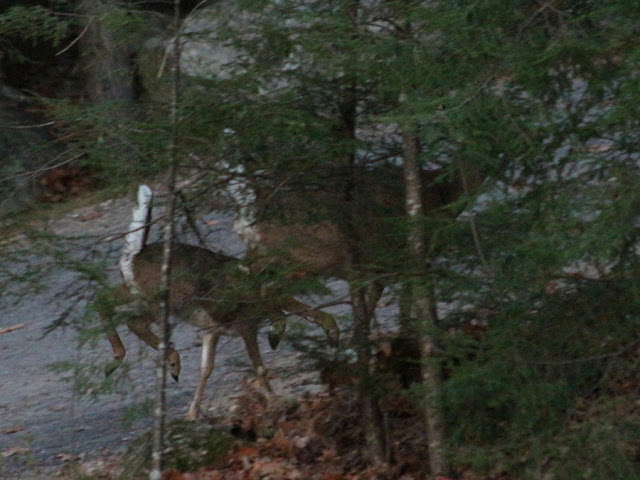I decided to post early this week so I could wish everyone a Happy Thanksgiving! I hope you found a way to connect with your family and friends - we need some warmth in our lives on this cool and wet Thanksgiving 2020.
After a cold morning in Meredith the ice on Lake Wicwas was creeping out into the lake, further evidence that winter is getting closer.
But, to my surprise, Betty and Harold are still here! I had seen a couple of loons fishing far out in the lake several times this week and they were acting suspiciously like our two loon chicks.
 |
| Harold and Betty, still on Lake Wicwas. |
But they were also fishing in deep water, and I wasn't confident I could differentiate between five month old juveniles and molting adults this late in the year. So I sent a few grainy pictures off to John Cooley at the Loon Preservation Committee, and he was able to confirm they are juveniles.
With that expert input I am confident these two are Betty and Harold. John said the scalloped pattern on their backs is a distinctive feature on juvenile loons.
 |
| They returned the next day and came close enough for a better look. |
He added that one and two year old "sub-adults" have a more subtle version of this pattern, but when it's this distinct one can be confident it's a juvenile.
John was pleased to hear that two of them are getting along well together in contrast to the sibling rivalry that loons often display. He noted also the fact they are foraging in deep water and catching large fish is a good sign as they move onto their new fishing grounds in the Atlantic Ocean. Our new loon couple that has taken over Harris Cove as their home appear to be excellent parents!
 |
| "Hey, are you going to share that?" |
Now we just have to hope they have the good sense to get out of Dodge before ice-in. It's nice to know we have observers on all corners of the lake who will keep watch as the ice closes in and reduces the take-off runways. It seems every year the LPC has to go out and rescue a loon or two that doesn't get off their lake in time.
I had another interesting wildlife encounter this week. I was on my to get the mail right around sunset when I came over a rise in the road and saw three deer standing in the middle of the road, mom and her two kids. Mom didn't hesitate for an instant, in fact, she acted so quickly that she literally leaped right over both her kids - which are pretty much full grown now - to dash off into the woods. One of the kids sprinted right off after her but the other just froze, kind of like the proverbial deer in the headlights. But then it regained it's composure and also ran off, but in the opposite direction.
 |
| It looked kind of like this. |
















































